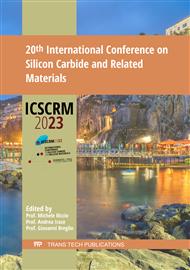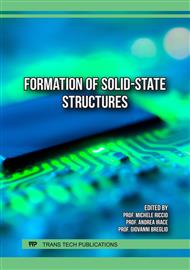[1]
Kimoto T, Fundamentals of Silicon Carbide Technology: Growth, Characterization, Devices and Applications, IEEE Press, Wiley, Singapore (2014).
Google Scholar
[2]
Heinze B and Lutz J, Surge Current Ruggedness of Silicon Carbide Schottky- and Merged-PiN-Schottky Diodes, in Proceedings of the 20th International Symposium on Power Semiconductor Devices & IC's (Orlando, FL, 2008) pp.245-248.
DOI: 10.1109/ispsd.2008.4538944
Google Scholar
[3]
Information on https://www.disco.co.jp/eg/solution/library/grinder/warpage.html
Google Scholar
[4]
Information on https://www.disco.co.jp/eg/solution/library/polisher/strelief.html
Google Scholar
[5]
Jung Y and Kim J, Formation of Ni-silicide at the interface of Ni/4H-SiC, Journal of the Electrochemical Society 158, H551 (2011)
DOI: 10.1149/1.3567531
Google Scholar
[6]
Zekentes K, Vasilevskiy K, Hrsg. Advancing Silicon Carbide Electronics Technology I. Metal Contacts to Silicon Carbide: Physics, Technology, Applications: Materials Research Forum LLC; (2018)
DOI: 10.21741/9781945291852
Google Scholar
[7]
Hellinger C, Rommel M, Bauer A, Empirical model of backside low-ohmic nickel contact formation on n-type 4H-SiC, submitted to Material Science Forum 2024 (2023).
DOI: 10.4028/www.scientific.net/msf.1004.718
Google Scholar
[8]
Bliedtner J, Müller H, Barz A. Lasermaterialbearbeitung. Grundlagen - Verfahren - Anwendungen - Beispiele. München: Fachbuchverl. Leipzig im Carl-Hanser-Verl.; (2013)
DOI: 10.3139/9783446429291.fm
Google Scholar
[9]
Zhang Z, Cui J, Wang B et al. A novel approach of mechanical chemical grinding. Journal of Alloys and Compounds 2017; 726: 514 – 524
DOI: 10.1016/j.jallcom.2017.08.024
Google Scholar
[10]
Agarwal S, Rao PV. Experimental investigation of surface/subsurface damage for-mation and material removal mechanisms in SiC grinding. International Journal of Machine Tools and Manufacture 2008; 48: 698 – 710
DOI: 10.1016/j.ijmachtools.2007.10.013
Google Scholar
[11]
Rupp R, Kern R, Gerlach R. Laser backside contact annealing of SiC power devices: A prerequisite for SiC thin wafer technology. Power Semiconductor Devices and ICs (ISPSD), 2013 25th International Symposium on 2013: 51 – 54
DOI: 10.1109/ispsd.2013.6694396
Google Scholar
[12]
Silva M de. Low Resistance Ohmic Contact Formation for Silicon Carbide Power Devices [Thesis]. Hiroshima: Hiroshima University; (2017)
Google Scholar



